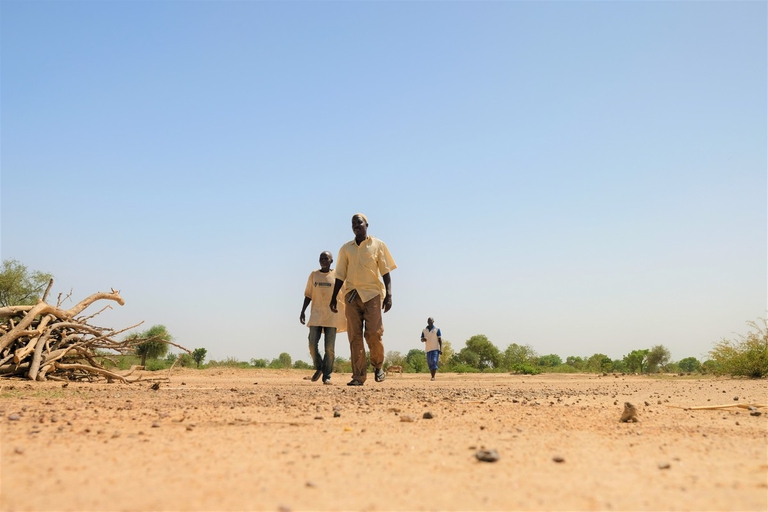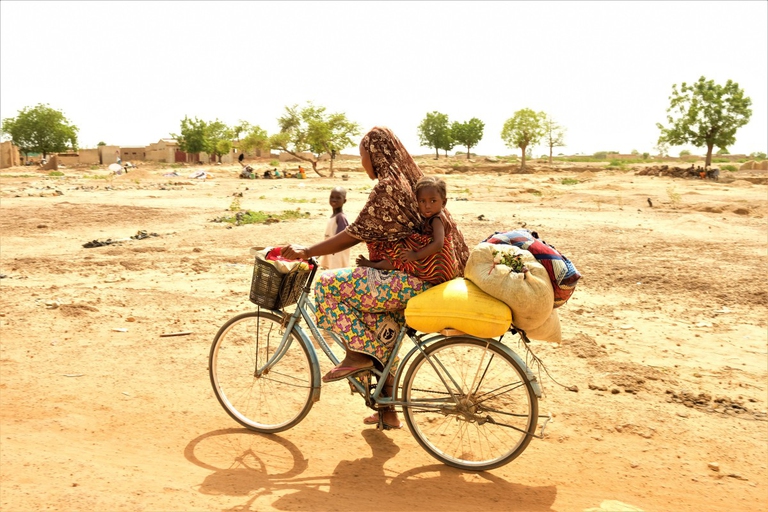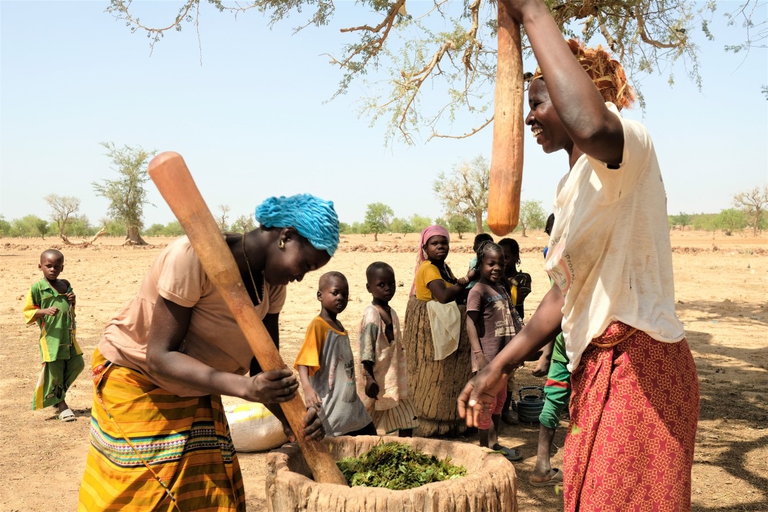
As per tradition after 12 years India held Mahakumbh, the world’s largest spiritual congregation that has been attracting pilgrims from across the globe.
Burkina Faso is one of the countries most severely affected by desertification. It’s at the mercy of water scarcity, soil degradation and humanitarian crises. The stories of hope and fear of a people fighting for their land.
“We do what we can to grow millet, but the rainy season gets shorter every year and the land is no longer productive”. Not far from his village, in a rural area of Ouagadougu district in northern Burkina Faso, Moussa looks to the sky, despondent. He’s dripping with sweat as he and his brother Idriss till the field with a rudimentary wooden plough. Moussa tries to help the donkey pull, while Idriss uses all his weight to drive the ploughshare deeper into the dried-up earth.
In some places in this semi-arid region, the soil is as hard as concrete, whilst in others it’s too sandy and can’t be used for agriculture. Except for some bushes and the occasional tree, the horizon is bare, dusty and incandescent. Nature itself, here, is an expression of suffering. “Now we’re also threatened by farmers who want to take over the last fertile lands. If things go on like this, we’ll have to move,” Idriss states, disillusioned.
The two Burkinabe farmers are experiencing the same dramatic pressures of food insecurity and political instability faced by millions of people in sub-Saharan Africa because of the current climate crisis. Burkina Faso’s northern regions, like the entire Sahel belt, have for decades been suffering the consequences of desertification, soil degradation and increasingly frequent droughts.
On the World Day to Combat Desertification and Drought, 17 June, the UN Secretary General presented a report stating that every year these factors cause 24 billion tonnes of arable soil to disappear worldwide. The economic consequences of desertification and land degradation amount to losses worth 490 billion dollars a year. The repercussions are severe and wide-ranging. According to UN data, sustenance for at least a billion people across over 100 countries is at risk.
The worst hit areas are sub-Saharan Africa and the Sahel in particular, where environmental degradation has been very rapid. This has led to the disappearance of entire expanses of arable land and has threatened livestock farming. The dire situation is worsened by widespread poverty, low education levels, territorial isolation and growing political instability, which in turn has led to a lack of investment in development. It’s no coincidence that 60 of the estimated 135 million climate refugees that will be forced to migrate due to desertification by 2035 will move from sub-Saharan Africa towards North Africa and Europe.
Desertification is an often irreversible process that affects the Earth’s surface where the biosphere has disappeared, leading to soil degradation and loss of nutrients and, therefore, decreased land fertility. Soil salinity levels consequently increase, intensifying erosive phenomena and landslides as well as extreme climatic events.
In 1994, following the increasingly frequent humanitarian crises caused by famines in the Sahel, the UN Convention to Combat Desertification was drafted to address the issue. Desertification was described as “soil degradation in arid, semi-arid and sub-humid dry areas resulting from various factors including climate variations and human activity”. These last two points are key in highlighting the causes directly and indirectly related to anthropogenic impact. Global warming is leading temperatures to increase in the Sahel while also causing a diminution in season rainfall, which becomes both too rare and too intense when it does occur. Direct human action – deforestation, excessively intensive farming practices on the small amount of fertile soil available, and stress on surface and subterranean water basins – exacerbates the issue.
In the entire Sahel belt, where land and resources are diminishing, population growth has put the environment under even more pressure. This leads to a further worsening of land degradation and, according to projections, the situation will only become more critical. In fact, according to the United Nations, the area’s population will nearly triple by 2050 – rising from 75 to almost 200 million.
Without direct intervention through sustainable development and land recovery policies in the region, migration phenomena will keep increasing. The same goes for the instability caused by the rush for the few remaining resources.Djimé Adoum, Executive Secretary for the Comité permanent inter-etats de lutte contre la sécheresse dans le Sahel (CILSS)
Burkina Faso is a clear example of these dynamics. It’s a poor nation, ranking 183rd on the Human Development Index, in which 80 per cent of 20 million inhabitants survives on farming and 45 per cent lives below the poverty line. But most of all, the country is in a full-blown climate emergency. One third of the national territory is degraded: over 9 million hectares of productive land have been lost. This process leads to 360,000 hectares becoming unusable every year, according to UN estimates. Add to this a 15 per cent decrease in rainfall between 2000 and 2009, and a 0.8 degree increase in average temperatures from 1970 to today.
Thomas Sankara, revolutionary President and pan-African icon, baptised Burkina Faso “The Land of Upright Men” in 1984. Until a few years ago, the country was considered immune to inter-communal conflicts and the jihadist advance in the Sahel. At the very least, the signs of these problems weren’t as clear as in neighbouring Mali and Niger. Starting in 2015, however, clashes started to occur in the northern regions, causing a collapse into instability. Increased activity and attacks by terrorist groups have only exacerbated the situation.
An increase in inter-ethnic conflict – especially in the last year – completes the picture. The Fula (Peul in French) are semi-nomadic farmers who have clashed with Mossi sedentary farmers, among others. The motives feeding the conflict are diverse and concurrent, and create opportunities for jihadist extremism to take root. The areas where the clashes are most severe are the poorest and most marginalised, where unemployment is high, and where land and water resources have been most affected by climate change.
Yacouba Sawadogo, an old Burkinabe farmer, was awarded the Right Livelihood Award (know as the alternative Nobel Prize) in 2018 for his efforts in fighting desertification by recovering old agricultural practices. He knows the situation well: “Conflicts are caused by people’s greed. Because of its scarcity, I believe land causes rifts among people. Conflicts are caused by the lack of arable land as well as it being sold off. Our parents were farmers, they left us their land in inheritance. If we start selling it, while the population grows, we’ll have trouble in the future”.
Read more: Yacouba Sawadogo, the African farmer who stopped the desert
All of these variables seem to point to a single, overarching issue: the relentless disappearance of fertile land, the problem that Moussa and Idriss were referring to. The problem Sankara, the father of the nation, prophetically centred his policies on with a programme of agrarian reforms and reforestation, over thirty years ago.
Siamo anche su WhatsApp. Segui il canale ufficiale LifeGate per restare aggiornata, aggiornato sulle ultime notizie e sulle nostre attività.
![]()
Quest'opera è distribuita con Licenza Creative Commons Attribuzione - Non commerciale - Non opere derivate 4.0 Internazionale.
As per tradition after 12 years India held Mahakumbh, the world’s largest spiritual congregation that has been attracting pilgrims from across the globe.
Workers in tea gardens of West Bengal, India, that produces Ctc tea for domestic consumption complain that they have been devoid of basic facilities while political parties make hollow promises during every elections which are never fulfilled.
India is in the middle of the elections, but sadly none of the politicians have uttered a word on man-animal conflict that has been devouring several lives every year.
Manipur, a state in north-east India, is still reeling under the tremors of violence that broke out last year devouring lives and paralyzing the economy.
The government of Tanzania is currently planning to evict more than 80.000 indigenous Maasai people from their ancenstral land
A new UNU-INWEH report on the global bottled water industry reveals the massive scale of this market and the lack of strict quality controls.
Isatou Ceesay founded a social enterprise that is helping to fight plastic pollution and empowering women and young people to gain economic independence.
In 2020, Mihela Hladin made a radical decision that many, in recent times, have probably considered. This is her story, with photos by Matt Audiffret.
The Brazilian government has started evicting illegal gold miners, responsible for the health emergency that has hit the Yanomami people.











